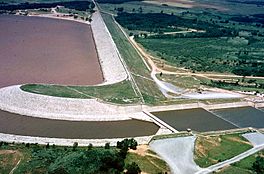Great Salt Plains Lake facts for kids
Quick facts for kids Great Salt Plains Lake |
|
|---|---|

Aerial view of Great Salt Plains Lake Dam on the Salt Fork Arkansas River
|
|
| Location | Alfalfa County, Oklahoma |
| Coordinates | 36°44′34.34″N 98°11′18.31″W / 36.7428722°N 98.1884194°W |
| Lake type | reservoir |
| Basin countries | United States |
| Surface area | 9,300 acres (3,800 ha) |
| Average depth | 4 ft (1.2 m) |
| Water volume | 31,420 acre⋅ft (38.76 hm3) |
| Shore length1 | 91 mi (146 km) |
| Islands | 1 |
| 1 Shore length is not a well-defined measure. | |
Great Salt Plains Lake is a large reservoir (a human-made lake) in Alfalfa County, Oklahoma, United States. It's part of the Salt Plains National Wildlife Refuge. The lake gets its name from the salty areas nearby and the Salt Fork Arkansas River, which was dammed to create it.
This lake is special for two main reasons. First, many different kinds of birds love Ralstin Island, which is a protected area in the lake. Second, you can find unique selenite crystals along the shore. These crystals are famous for a cool hourglass shape inside them.
About the Lake
The idea to build a dam in the Great Salt Plains area came up in 1931. The United States Army Corps of Engineers wanted to control floods. Congress approved the project in 1936. Workers started building the dam in September 1938 and finished it in July 1941.
The lake can hold about 31,420 acre-feet of water. It covers an area of 9,300 acres (about 38 square kilometers). The shoreline stretches for 91 miles (about 146 kilometers). The average depth of the lake is only 4 feet (about 1.2 meters). The water in the lake is salty, but it's only about one-fourth as salty as the ocean.
Wildlife at the Lake
Ralstin Island was formed when the lake was created. It's a very important place for birds to nest. You can find blue herons, great egrets, and ibis here. It's the biggest breeding spot in Oklahoma for the white-faced ibis.
The lake is also home to different types of fish. You might find catfish, saugeye (which are related to walleye), sandbass, and hybrid striped bass.
In 1958, the State of Oklahoma leased 800 acres (about 3.2 square kilometers) of land to create a state park.
Selenite Crystals
On the western side of the lake, visitors can dig for special selenite crystals. What makes these crystals unique is an hourglass shape inside them. This shape is only found in crystals from the Great Salt Plains.
Scientists believe that millions of years ago, a shallow sea covered this area. When the water level rose and fell many times, it left behind layers of salt. Even today, salty groundwater flows just a few feet below the surface. When this water evaporates, it leaves more salt on the ground. This process also helps create the selenite crystals that people love to collect.
Future of the Lake
The lake sometimes experiences large fish kills, like the one in 2011. During that year's extreme drought, the lake's average depth dropped to just 2 feet (about 0.6 meters).
Experts say the lake has become shallower over time. This is due to silt (fine dirt) building up and runoff from farms. When summers are very hot and dry, the salty water becomes even more concentrated. Bacteria in the water then use up most of the oxygen as they break down plant and animal matter. This leaves too little oxygen for the fish to survive.
Officials from the U.S. Army Corps of Engineers are concerned about the lake's future if nothing changes. Some ideas to help the lake include:
- Opening the dam to let the lake water flow into the river.
- Removing the silt from the lake bed, which could be very expensive.
- Plugging the dam to raise the water level.
If no action is taken, the lake might not be able to support fish, and many birds could leave the area.
Recreation
The Great Salt Plains State Park is located right on the shores of Great Salt Plains Lake. There are many fun things to do at the park. You can go boating, camping, picnicking, swimming, hiking, and mountain biking. The park has places for RVs and tents, restrooms with showers, cabins, and picnic spots. There are also group shelters, a swimming beach, playgrounds, boat ramps, a fishing dock, and trails for horseback riding.




